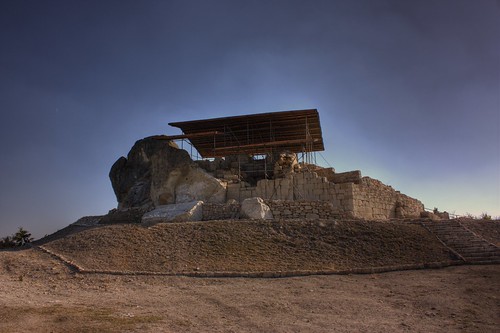

Κοντά στο Βουλγαρικό χωριό Татул (Τατούλ), στην διοικητική περιφέρεια του Момчилград (Μόμτσιλγκραντ) έχει βρεθεί σημαντικό Θρακικό ιερό με πέτρινη σαρκοφάγο σκαλισμένη πάνω στον ψηλότερο βράχο...

Σύμφωνα με τους αρχαιολόγους, το μέρος ήταν αρχικά το σημείο ταφής ενός μεγάλου Θράκα βασιλέα, ο οποίος μετά τον θάνατο του θεοποιήθηκε και γύρω από το τάφο του άρχισε να αναπτύσσεται ένα σημαντικό ιερό... Οι αρχαιολόγοι θεωρούν πολύ πιθανόν ο τάφος να είναι του ίδιου το Ορφέα, ο οποίος πριν αποκτήσει τον μυθολογικό του μανδύα, ήταν ένας μεγάλος βασιλέας της Θρακικής φυλής των Κικόνων που ζούσαν στην περιοχή. Μάλιστα η θέση αυτή των αρχαιολόγων ενισχύεται από το γεγονός ότι η ταφή του βασιλέα έγινε υπέργεια πάνω σε λόφο κάτι το οποίο ήταν πολύ σπάνιο και σε αρχαίες πηγές αναφέρονται μόνο δύο περιπτώσεις: του Ορφέα και του Ρήσου.

Γύρω από τον τάφο έχουν βρεθεί περί τους 35 πήλινους βωμούς του 19ου με 18ου αιώνα π.Χ. και εδώλιο της Εποχής του Σιδήρου που παρίστανε μια γυμνή αντρική φιγούρα...

Πέτρινα τείχη ανεγέρθηκαν γύρω από τον χώρο λατρείας την περίοδο από τον 4ο έως και τον 1ο αιώνα π.Χ.. Γύρω στον 4ο με 3ο αιώνα π.Χ. ανοικοδομήθηκε μεγάλο ιερό - μαυσωλείο...
Οικοδομική δραστηριότητα υπήρχε και την περίοδο του 2ου με 3ου αιώνα μ.Χ.. Τον 4ο με αρχές 5ου αιώνα, την περίοδο, δηλαδή, του εκχριστιανισμού της περιοχής της Ροδόπης το ιερό μετατρέπεται σταδιακά σε οχυρό του τοπικού ηγεμόνα και κατασκευάζεται αμυντικός πύργος. Το συγκρότημα θα υποστεί σημαντικές ζημιές από σεισμούς που έλαβαν χώρα τον 12ο και τον 14ο αιώνα...





Η ανακάλυψη του μνημείου έγινε το 2000.
Σύνδεσμος σε χάρτη / Link to Map: 41° 32' 30''N, 25° 32' 43''E

Σύμφωνα με τους αρχαιολόγους, το μέρος ήταν αρχικά το σημείο ταφής ενός μεγάλου Θράκα βασιλέα, ο οποίος μετά τον θάνατο του θεοποιήθηκε και γύρω από το τάφο του άρχισε να αναπτύσσεται ένα σημαντικό ιερό... Οι αρχαιολόγοι θεωρούν πολύ πιθανόν ο τάφος να είναι του ίδιου το Ορφέα, ο οποίος πριν αποκτήσει τον μυθολογικό του μανδύα, ήταν ένας μεγάλος βασιλέας της Θρακικής φυλής των Κικόνων που ζούσαν στην περιοχή. Μάλιστα η θέση αυτή των αρχαιολόγων ενισχύεται από το γεγονός ότι η ταφή του βασιλέα έγινε υπέργεια πάνω σε λόφο κάτι το οποίο ήταν πολύ σπάνιο και σε αρχαίες πηγές αναφέρονται μόνο δύο περιπτώσεις: του Ορφέα και του Ρήσου.

Γύρω από τον τάφο έχουν βρεθεί περί τους 35 πήλινους βωμούς του 19ου με 18ου αιώνα π.Χ. και εδώλιο της Εποχής του Σιδήρου που παρίστανε μια γυμνή αντρική φιγούρα...

Πέτρινα τείχη ανεγέρθηκαν γύρω από τον χώρο λατρείας την περίοδο από τον 4ο έως και τον 1ο αιώνα π.Χ.. Γύρω στον 4ο με 3ο αιώνα π.Χ. ανοικοδομήθηκε μεγάλο ιερό - μαυσωλείο...
Οικοδομική δραστηριότητα υπήρχε και την περίοδο του 2ου με 3ου αιώνα μ.Χ.. Τον 4ο με αρχές 5ου αιώνα, την περίοδο, δηλαδή, του εκχριστιανισμού της περιοχής της Ροδόπης το ιερό μετατρέπεται σταδιακά σε οχυρό του τοπικού ηγεμόνα και κατασκευάζεται αμυντικός πύργος. Το συγκρότημα θα υποστεί σημαντικές ζημιές από σεισμούς που έλαβαν χώρα τον 12ο και τον 14ο αιώνα...





Η ανακάλυψη του μνημείου έγινε το 2000.
Σύνδεσμος σε χάρτη / Link to Map: 41° 32' 30''N, 25° 32' 43''E
[ENG] Orpheus' tomb. A very important ancient Thracian sanctuary was discovered in 2000 near the Bulgarian village Tatul, district Momchilgrad. According to the archaeologists, it was the sanctuary and the tomb of an influential Thracian ruler who was deified after his death. The ancient sources describe the ritual of burying leaders overground - on the top of a hill - as extremely rare, mentioning only Orpheus and Rhesus as two of the leaders who were buried this way. Around 35 Bronze Age altars used for making sacrifices to gods were found during the excavations. One of the altars, made of very compact clay, is larger than the rest, which probably means that it was the main altar of the shrine. A stone wall was erected surrounding the hill between the 4th and the 1st century B.C.. Around 4th-3rd century B.C. a big stone temple - mausoleum was built. Several new buildings were constructed in the 2nd-3rd century A.D.. Cult practices continued uninterrupted until the adoption of Christianity in the late 4th and early 5th century, when it was converted into a private estate and remained so until the end of the 12th century. The complex also suffered from two earthquakes, once in the 12th century B.C. and once in the 14th century A.D..
[BUL] Светилището на Орфей при село Татул, Момчилградско.
[BUL] Светилището на Орфей при село Татул, Момчилградско.









2 comments:
Your photographs are fantastic, and it's always good to learn new facts from history. It's interesting how they discover it year 2000? Anyway, great post and even greater picture!
Thank you very much!!
I suppose the locals knew it earlier but the "scientific" discovery happened in 2000...
Post a Comment